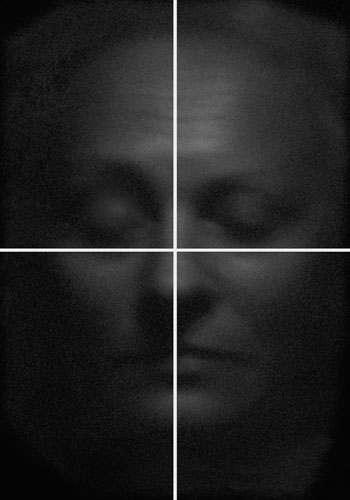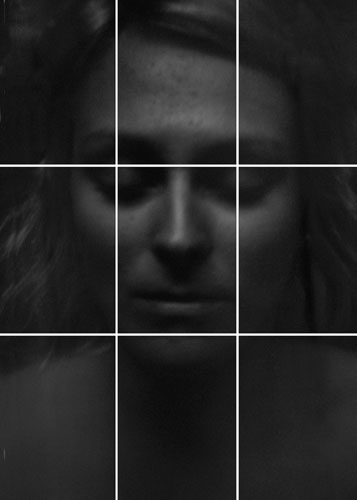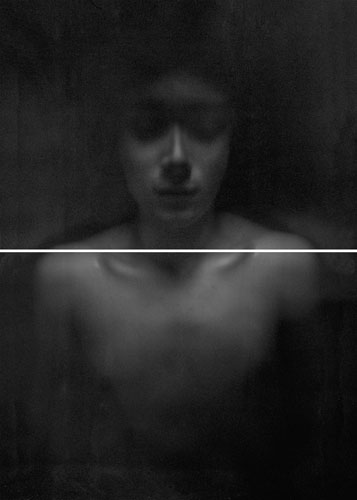


Born of Non-being. About Dominika Sadowska’s Traces.
They emerge from the abyss. From absolute, deepest void.
Their age, sex and background are unimportant. Their physiognomies melt in the dark. Although they are all different, they all seem to resemble one another in a certain way. They float in a mysterious, unidentified space as if in formalin. They are calm and motionless. Their faces are serious and eyes closed. Are they asleep?
Blurry features of their obscure faces resemble a photograph which faded long ago. They are icons of absence, of non-presence. Who are those figures, blended with the background from which they have grown so thoroughly that they almost amalgamate with it and are very hard to notice for an untrained eye? Indistinct faces give no answers, they remain unmoved, enigmatic and ephemeral - one could even think that they do not exist, that they are only a fancy of an untamed imagination, liable to ascribe anthropomorphic qualities to abstract shapes, spots and splashes of paint.
Dominika Sadowska’s Traces at first glance resemble minimalistic, monochromatic canvases. Uniformly black wooden panels, single or in sets of two, four or six, form modules of a larger whole, dividing the plane of the wall by means of methodical geometry. Their presence seems to needs no other justification than themselves; they are self-reflexive and completely lack any narrative elements, like minimalistic objects by Robert Morris. Their rational, cool form appears to have a sedative effect on the viewer: there is no more to them. So let yourself be drawn into this concise though very expressive form of pure geometry - into the absolute abyss of blackness.
And then they appear. At first they seem to be but a mockery of the senses, a reflection of lamp-light falling on a smooth surface of tarry blackness. Or perhaps it is a mockery of matter which does not care that we want to create forms that come close to perfection? In a little while you will get rid of doubts. From the thick, Erebus-like blackness shapes slowly start to appear, shapes which you can combine into a larger whole. Nose, lips, forehead. Eye sockets disappear in undisturbed darkness and only here and there are you able to notice the soft convex curve of a closed eyelid. Those faces look as if somewhere, sometime ago, on the day which had long disappeared in the past, they were impressed on the surface of some light-sensitive shroud. They are intimate coffin portraits from which time has erased clarity and changed them into enigmatic signs, emblems of forgotten life. At the same time they strike the viewer with their exceptional realism - so from time to time you may have the impression that those wooden panels are actually tar-black LCD screens and that those figures have become immobilized for anly a short while. You realize that you are looking at those portraits with fear, uncertainty and a mysterious suspicion that they will start moving. Or - even worse - that they will open their eyes.
Sadowska’s works mesmerize the viewer with their calmness and formal modesty. Everything here is in place - we will find no unnecessary element. It is hard to believe that those faces so softly drawn, so subtly melting with the background, faces that remain on the verge of visibility, have been created by a human hand. The authoress has managed to grasp this transient moment when the portraits begin to escape perception, although they do not disappear completely. A little more blackness and they would be completely unrecognizable. Considering the fact that Sadowska uses such a difficult technique, finding this golden means is a serious achievement. Her laborious series - photographs taken with the use of a pin-hole camera, screened on a computer and then screen printed - strikes us with its technical competence. It is the competence of an artist who deftly and consciously moves across the borders of photography - because even though she used light-sensitive paper, Traces resemble paintings. Thair harmony and delicate yet clear chiaroscuro bring to mind Reneissance paintings.
The authoress first showed her fascination with the works of old masters in her previous series called Untitled. Faces of those Reneissance madonnas whom the pin-hole camera deprived of their original proportions look like demonic phantoms and become a perverse pendant to the multitude of images of Beelzebub’s sons who populate various images of Judgment Day, so often painted at the time. In another series by Sadowska screen printed faces of actresses from erotic movies make us think of extatic countenances of Christian mystics. In Traces allusions to the painting tradition are not so evident - as they are not situated in the purely iconographic sphere but also in the realm of specific sensibility, characteristic for old art. Sadowska avoids easy solutions, circus tricks played with meaning and form which we so often observe in the works of artists who declare their respect for art of old masters. Sadowska’s works do not make use of visual trivia, they do not mock tradition but at the same time they do not use it mechanically or without reflection. They are rather an atttempt at broadening its meanings and finding in classical, timeless beauty something that seemed to have been devoid of its original value under the pressure of time and different aesthetics. If we should bring those faces out from darkness - faces we see in Traces - and clean these images but a little from the black dust that envelopes them, their classical value would become clear in all its aspects. However, the artist purposefully makes them obscure and hardly visible, hiding the formal beauty of her portraits behind a screen of translucency. In order to make them unreal and conceal them, Sadowska uses also a different technique -she divides one portrait into a few panels, forcing the viewer to reconstruct the features of the portraited person from many different fragments. Geometrical shapes of certain elements of the work demolish those portraits from the inside as if to question their reality. On the other hand, the images which emerge from monochromatic nothingness break down the rationality of those black rectangles. They seem to be a challenge to the definiteness and impersonality of cold geometry. The whole dynamism of Traces, their ambiguous, fascinating power, seems to be built on this dychotomy - on the play between the frugal, minimalistic form and the probing narrative of the photographs.
However, the two aesthetic orders between which the artist moves - the traditional and the avant-garde one - only apparently balance each other out. Actually Traces function in both these orders at the same time and their value is produced as the result of the questioning of the controversy between the traditional and the modern. In this attempt at envisaging nothingness, the antithetical nature of those two languages between which the authoress keeps moving is erased and transferred into the sphere of the aesthetic category of the sublime, in which such different painters as van Eyck, Malewicz, Rembrandt and Kapoor fit equally well. The representatives of this category have always been frenetically in love with infinity. "There is something in emptiness and nothingness that fascinates me enormously. «Nothing» is the most creative word in the world", Robert Barry used to say, and he was not alone in this opinion. Nothingness which made such an impression on the imagination of artists from the circles of conceptualism and minimal art, was originally rediscovered by the founders of the great avant-garde who cleaned the sublime from the coating of symbolism. Malewicz places a black square on his grave - the modern incarnation of the Absolute. The impenetrable, eternal blackness set within the frames of the most perfect geometrical figure in his (and many other people’s) opinion. Blackness is the symbol of absolute emptiness, it is eternity caught in the act, the beginning and the end. Everything emerges from it and everything will return to it. At the same time it horrifies people and draws us towards it like a magnet, strumming the sensitive chords of our amor moriendi. As the figure of Mystery, so eagerly employed by artists of most styles and historical periods, it was able to speak convincingly only in the 20th century. And that is how it speaks in Sadowska’a works.
Therefore the characters in Traces are not something that breaks down minimalistic geometry but something that completes it - they are the other side of the same coin. They are its supplement, high point, punchline. They are the same word spoken in another language. They do not mock it but are born of it. Quietly, slowly, without any unnecessary gestures and words.
They emerge from the abyss.
Gabriela Jarzębowska


Copyright ©2009 Galeria FF ŁDK, Dominika Sadowska, Gabriela Jarzębowska